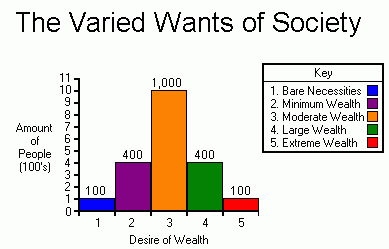|
|||||||||||||
|
A Treatise In Communist Economics By Punkerslut
Introduction When an economic treatise is composed, there is almost no doubt that it is one based on a system of free, or somewhat limited, trade. The reason for that is quite easy to understand. Economics is a sociological study: it seeks to grasp and understand the fluctuation and mechanics of the interaction between people of the same society. In an economic system where the people are free to buy or sell anything they own at any price they want, there is a fervent interest of sociologists to understand what the rules of exchange are -- such sociologists who are known as economists. Questions will be raised: Why does this person sell this at this price? We must understand the interests of other parties: consumers, workers, competitors, and the rules that give economic strength to one party or another, or what causes one party to increase or decrease in the number of members. The nature of people, in groups, a society, is studied by economics. In a Communist economy, many of these questions are mute. While it may be examined by sociologists, to understand what kind of society it would be, it is almost completely ignored (and even despised) by economists. Why is that? Because the elements often traditional in economic study, such as competition or rent trends or price fluctuation, are gone. Private interest being able to regulate the entire economy is the basis of a Capitalist economy. In a Communist economy, the price, production, distribution, and consumption of goods is decided by public interest. The primary element of economic study, private interests, is eliminated, for the most part. But, in a Communist economy, the exchange of wealth between members can still be discussed. It is in this treatise that I hope to expand upon the idea of Communist economics. The Treatise: The Question of the Allocation of Labor
Before continuing in this treatise, I feel that it is important to define a Communist system accurately. By a Communist economy, I mean a system of production and distribution, where each person is paid according to the value of their labor. All of this is being regulated by the public, instead of being regulated by the private interest -- as would be the case if it was a Capitalist economy. With that said, I continue with this economic treatise of Communism. When something is produced and sold as a commodity, it can be sold in various forms. Of the particular form that I am talking about, I mean the readiness of its use. Several hundred planks of wood and one or two tons of cement are less ready to use than a house; frozen vegetables are less ready to be eaten than a warm, cooked meal. Thus we have a variety of forms of readiness to consume when an item is sold. The production that goes into a commodity when produced to be distributed, such as a person cooking their own meal, this production I have decided to call "domestic labor." The importance of comparing these types of labor can be seen in a Communist economy. Since it is the collective that determines what types of industry to erect, they must choose whether to sell houses, or only the materials to build a house -- whether to sell clothes or only fabric. When examining the effectiveness of industrial labor versus domestic labor, there is no doubt that industrial labor tends to be much more productive. However, materials to produce something else - while of lesser exchange value - it may still be more desired. For example, a great deal of preparable food is probably more desired than already cooked food when going on a trip or a journey for days. Also, a person may find pleasure in building their own home, or cooking their own food. Sometimes those things which are considered irksome labor to some are actually a joy or routine happiness for others. Increasing the preparedness of a commodity means the more industrial labor must be done by the whole. Allow me to demonstrate with an example. In one region, there are 2,000 members of the work force, half working in agriculture and the other half in manufacturing. Each worker works 1 and 1/2 hours a day, but no product is sold ready to consume -- it requires domestic labor to make it consumable (and by "consume" here, I mean use). Food is sold frozen, cloth and sewing materials are sold, and perhaps to avoid selling an unprepared commodity that not everyone is capable of preparing themselves, apartments are rented. In the agricultural industry, there are four sectors: two producing wheat, those producing vegetables, and those producing fruit. Each sector has 250 workers. The manufacturing industry is similarly divided into four sectors: one sector converting food (such as wheat) into a more consumable form, one sector in extracting and refining metals, and 2 sectors producing a variety of goods, such as bicycles, toys, street signs, and other goods. Each sector has 250 laborers. In both industries, all sectors, each worker works 1.5 hours. Each agricultural worker is capable of producing 3 meals for every half hour of labor, thus totaling 9 meals a day for their labor. This means 4.5 meals are available to each agricultural worker and 4.5 meals are available to each manufacturing worker (since 1,000 workers working 1.5 hours each day to produce 9 meals a day, that means 9,000 meals a day to the 2,000 working population). And though it is true that agriculture usually reaps its harvest not everyday, but at one time in the year, I am overlooking this fact to simplify my scenario. Each industrial worker is capable of producing 3 pairs of clothes, 3 moderately valuable items of enjoyment (such as a toy or an electronic device), or 3 pieces of furniture every half hour of labor. Since each industrial labor works 1 and 1/2 hours, they will produce roughly: 9 pairs of clothing per textile worker per day, 9 toys per worker per day, and 9 pieces of furniture per worker per day. Again, I admit this may seem overly simplified, but if this is the impression the reader is getting, understand it is only because I do not want to draw a too complicated scenario. So, for 1,000 industrial laborers, each day, there is produced, 3,000 pairs of clothing, 3,000 items of enjoyment, and 3,000 pieces of furniture. 1,500 of each item is distributed to the industrialist workers and 1,5000 of each item is distributed to the agricultural laborers. Thus we have a vision of an economy in which each person is satisfied. Though each person's industry, of 1 and 1/2 hours of labor each day, each person has their needs satisfied. But, to demonstrate what economic fluctuation means in a Communist economy, let's throw in some variables to this scenario I above described. Imagine that a new need is universally desired by this hypothetical Communist economy. Let's say that each person gains an interest in music, a very strong interest. Let's say that a factory by this population is activated to produce music CDs. Whatever the production rate and whatever the desire to consume is, let's say that it requires 500 laborers -- musicians, producers, manufacturing workers, etc.. The agricultural industry loses 250 workers and so does the manufacturing industry. What is the end result? Well, each industry of manufacturing and agriculture still need to produce the same amount with fewer workers. With 1,000 workers working 1.5 hours each or 1,500 labor hours a day, each industry is capable of satisfying the needs of society. Now each industry has 750 workers, and if they worked 1.5 hours each day, then they only have 1,125 labor hours each day, not satisfying the needs of the population by 375 work hours per day. Each person would have to work 2 hours a day, an additional 1/2 hour. Of course, they are trading this additional half hour for more luxury, particularly what the other 500 workers are doing to produce music products. Here we can see the obvious fluctuation of the economy among a Communist society. Perhaps the next year, technology will take a leap, and each worker must work only 1 hour. Or perhaps a natural disaster strikes, and for 2 months, they need to work 3 hours a day to rebuild. Maybe the interest of society in a product or service will wax or wane. I have accurately described the relation of industrial labor to other industrial labor. But, as the title of this treatise denotes, we must understand industrial labor versus domestic labor. For satisfying the need of food, an industrial laborer -- with the aid of technology and specialization -- would require 2 minutes of labor to prepare food. In a home, a meal of adequate satisfaction would require 15 to 20 minutes, possibly more, to prepare, that is to say, with the use of domestic labor. The question concerning how accurate this hypothetical comparison is should need not much be addressed. It is overwhelmingly clear that industrial labor is by far more productive than domestic labor. One man cooking food will perhaps be able to make 20 or 30 meals in one day, if he works every hour. But only a few people with the aid of technology and specialization will be able to make hundreds or thousands in one day -- such is the case with fast food restaurants. So, then, if this society, of 2,000 people requires 3 meals a day, in terms of domestic labor, this means 1 hour of personal labor a day. However, if each meal is produced via industrial labor, this means 6 minutes of labor per person per day. In total, this is 2,000 hours (120,00 minutes) of domestic labor for 2,000 people. But, if industrial labor was employed, it would be a total of 200 hours (12,000 minutes) of industrial labor for the 2,000 people. However, if the population opted to have all of their food prepared by industrial labor, thus saving them a great deal of labor and increasing productivity by ten times, then each person must labor more industrially. A small force of people would be working to prepare this food and that means others in those other industries must work more, just like I demonstrated in the section where a music industry sprang up in this society. A person's total labor (domestic and industrial) might be 5 hours a day, if they prepared their own meals, but if food was prepared industrially, a person's total labor might be only 4 hours a day -- thus, saving them time and increasing productivity. The next question that arises is whether society would want to do solely industrial labor and no domestic labor. For some individuals, the normal, routine of day-to-day life make up desirable acts. Marx once said...
The worker's day does not start when he wakes, but it starts once his industrial labor ends. Those acts of domestic labor, with cooking, cleaning, and maintenance of house, car, or items make up a part of their life. Perhaps those 6 minutes of industrial are less desirable than 1 hour of domestic labor, because the industrial labor is purely irksome (for most) and domestic labor is part of day-to-day life. Of course, the opposite may be true. A person may know that domestic labor is unproductive and believe that only through industrial labor should we work, as a sort of work pride ethic. But, then again, all workers must realize that every moment not working, whether industrial or domestic, is a moment to let them relax, enjoy themselves, on engage in some hobby or recreational activity -- or, something to challenge themselves in. There is a fact here that must be recognized. Communism must be practiced with a respect to the fact that every human being is different, with different lifestyles and interests. To force people to live in a way that does not recognize them as different, is unjust and without appeal to either reason or justice. To quote Karl Marx again...
Thus brings me to my last scenario to be brought up with the Communist economy. In this economy of 2,000 workers, the previous fact must be realized and understood: each person is different, with different needs. One person may be very Thoreau-like in their needs: they only we need sustenance and no luxury items. Being allowed to explore a natural world and indulge in all emotions as all that they need to feel happy and live their lives contently. Some people need a low amount of luxury produced by industrial labor, and are easily pleased by it. Others need a moderate amount, while still others want large amounts, and finally some want estates of luxury to feel content and happy in their life. Each person is different in their needs. Now, assuming that the extremes of needs for luxury contain the least amount of people and the moderate levels of the need for luxury is where most people can be found. With all this set, what would the economy in this Communist society look like? With 2,000 people, let's say that 100 of them desire no luxury and 100 desire estates of wealth -- this accounts for both ends of the spectrum. Then for those who require only a small amount of luxury, there are 400, and those who require large amounts are also 400. Then, finally, there are 1,000 who want only moderate amounts.
Those who want nothing but sustenance work 1 hour, those who want a little luxury work 2 hours, moderate luxury 3 hours, high luxury 4 hours, extreme high luxury 5 hours, totaling 5,000 industrial labor hours a day from these 2,000 varied laborers. Now, let's examine the output of each class of laborers. Those who want nothing but the bare sustenance of living work 1 hour each day. If in agriculture, that means 6 meals a day. That means they eat the 3 meals, and the other 3 meals are traded for necessities like clothing or housing (obviously money -- as much as it is detested by the labor groups -- will allow for easier exchanges). If these bare sustenance workers labored in manufacturing for 1 hour a day, that would mean 6 manufacturing items, of which 3 they keep and the other 3 are traded for food. The 3 that they do keep are, most likely, necessities such as clothing and housing. Those who want minimal luxury work 2 hours a day. If in agriculture, that means 12 meals a day. That means they eat 3 to 6 meals, and the rest are traded for necessities and luxuries. The translation would mean 6 to 9 manufacturing products, 3 necessities, the other 3 to 6 being items of luxury. If in manufacturing, the 2 hours a day of labor would translate into 12 products. Some are kept, others are traded for food and other necessities. Those who want moderate wealth, the largest class, will be working 3 hours a day. In agriculture, that will translate to 18 meals, most of it probably exchanged for luxury items. In manufacturing, that will translate to 18 products, some of it exchanged for food. Those who desire much wealth will be working 4 hours a day. In agriculture, that means 24 meals, most of it exchanged. In manufacturing, 24 items, some of it exchanged. And, finally, those who want large estates of wealth work 5 hours a day. In agriculture, producing 30 meals, or in manufacturing, producing 30 products, all of which may be exchanged. The essential ethic of a Communist society would be this: you will be proportionately rewarded for the work that you do. Those who do little work will receive little pay, as those who do much work will receive much pay. The premises that I operate upon are based on justice and fairness. With this treatise complete, I hope I have offered a good theoretical consideration of a Communist economy: its fluctuations, its dynamics, and its very basic mechanics. Punkerslut,
|




